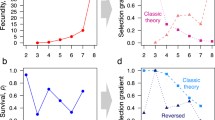Abstract
We examine the dynamics of an age-structured population model in which the life expectancy of an offspring may be mutated with respect to that of the parent. While the total population of the system always reaches a steady state, the fitness and age characteristics exhibit counter-intuitive behavior as a function of the mutational bias. By analytical and numerical study of the underlying rate equations, we show that if deleterious mutations are favored, the average fitness of the population reaches a steady state, while the average population age is a decreasing function of the average fitness. When advantageous mutations are favored, the average population fitness grows linearly with time t, while the average age is independent of the average fitness. For no mutational bias, the average fitness grows as $t^{2/3}$.
Similar content being viewed by others
Author information
Authors and Affiliations
Additional information
Received: 21 December 1999 / Revised version: 31 October 2001 / Published online: 14 March 2002
Rights and permissions
About this article
Cite this article
Hwang, W., Krapivsky, P. & Redner, S. Fitness versus longevity in age-structured population dynamics. J Math Biol 44, 375–393 (2002). https://doi.org/10.1007/s002850100128
Issue Date:
DOI: https://doi.org/10.1007/s002850100128




